FOR RELEASE: October 25, 2024
Minnesota’s Somali Americans: Key Insights into the 2024 US Elections
Empowering Voices, Shaping the Future
FOR INFO OR OTHER INQUIRIES:
Bayan Research Center
3055 Old Hwy 8 St. Anthony, MN 55418 – USA
612-345-7092
About Bayan Research Center
Bayan Research Center (BRC) is an independent non-profit think tank and policy analysis organization with offices in Minnesota. Registered in the United States, our mission is to conduct in-depth research and studies to generate innovative ideas and solutions that address educational, political, economic, religious, and social challenges at both local and national levels.
The Center seeks to generate ideas, enlighten public opinion, and inform society about global attitudes, issues, and social trends shaping East African communities in the United States. While we do not advocate specific policy positions, we focus on public opinion polling, demographic research, content analysis, and other data-driven social science research, collaborating with experts, governments, and non-governmental institutions. All our reports are available at www.bayanresearch.org.
Bayan Research Center is a nonprofit, tax-exempt 501(c)(3) organization.
Executive Summary
The election survey was specifically designed to capture the sentiments of the Somali American community residing in Minnesota, as well as those living outside the state. The aim was to develop a comprehensive understanding of electoral engagement within the Somali community, drawing insights from a diverse sample of 343 participants.
By including both local residents and individuals from outside Minnesota, the survey aimed to reflect a broad range of perspectives and experiences within the Somali community. The varied pool of respondents offered valuable insights into the nuanced dynamics of political preferences and priorities within this demographic. These diverse responses enriched the research findings, providing a more comprehensive view of electoral attitudes and preferences across the broader Somali American community.
Key Points:
- In the research, it was found that Kamala Harris and Tim Walz, the Democratic candidates, secured 189 votes, representing 55% of the total responses. On the other hand, Donald Trump and J.D. Vance, the Republican candidate, received 79 votes, accounting for 23% of the total vote share.
- The research findings revealed a significant trend: a 10% increase in respondents supporting the Republican candidate in the 2020 election compared to those intending to support the same party in the upcoming election. Conversely, the Democratic Party saw a 7% decline in voter support from the previous election to the forthcoming one.
- The findings indicate that Somali American citizens in Minnesota prioritize education, particularly school choice, as a key factor in their candidate selection. Although the state leans Democratic, effectively addressing this issue could potentially attract more votes from the Somali community toward Democratic candidates.
- Credibility emerged as a pivotal attribute, with 114 votes (33%) emphasizing the importance of trustworthiness and reliability in candidates. This suggests that political parties should rigorously assess and ensure the credibility of their candidates as a fundamental part of the electoral process.
- The resounding endorsement of civic duty was unmistakable as 'Very Important to Vote' garnered 295 votes, representing an overwhelming 86% majority. This emphatic response underscores the vital role of civic participation in shaping our collective future.
- The findings indicate a pressing need for the Somali community to receive citizenship education within the broader framework of civic education. This would entail the development and implementation of targeted curricula aimed at increasing awareness about the rights and responsibilities of citizens, as well as active participation in democratic processes.
Introduction
The United States is a melting pot of diverse cultures, with over 340 million people from various ethnic, racial, and socioeconomic backgrounds. Among these groups, the Somali community has become a significant part of the American fabric, particularly over the past few decades. Despite their contributions to the country’s cultural, economic, and social landscape, the Somali community has faced numerous challenges in exercising their right to participate in the democratic process. These challenges include barriers to voting, a deficiency in political awareness, limited representation, and socio-economic disparities that hinder their engagement in civic activities.
The 2020 presidential election saw a significant increase in voter turnout among minority groups, including Somalis, who have historically faced barriers to voting. However, despite this increase, the Somali community continues to encounter challenges that limit their ability to participate fully in the electoral process. These challenges include language barriers, a lack of civic education, and limited access to voting resources.
This study aims to explore the voting habits, attitudes, and perceptions of the Somali community in Minnesota and beyond. It seeks to examine the factors influencing their electoral behavior, including demographic, socioeconomic, and cultural factors. The study will adopt a mixed-methods approach, combining qualitative and quantitative methods to collect and analyze data. The qualitative component will involve in-depth interviews and surveys.
The findings of this study will provide valuable insights into the experiences of the Somali community in Minnesota and outside the state, contributing to a better understanding of the factors shaping their electoral behavior. Additionally, the study will offer recommendations for policymakers, community leaders, and civic organizations on how to enhance civic engagement within the Somali community and promote their participation in the democratic process.
Research Limitation
The time allocated for the research proved to be insufficient for conducting a comprehensive study, which may have impacted the depth of data collection and analysis. Since English is a second language for Somalis, communication and understanding may have posed challenges for both researchers and respondents. This limitation might have influenced the accuracy and clarity of the responses obtained.
Utilizing technology for election data collection introduced complexities and potential technical challenges that could have affected the data collection process. Issues related to technology proficiency and access may have impacted the quality of the data gathered.
Finally, due to budget constraints, the research was limited in its ability to conduct extensive data collection and analysis, potentially restricting the scope and depth of the study’s findings.
Research Scope
The aim of this research was to investigate the significance of elections within the Somali community, explore the factors influencing their voting decisions, and identify the primary motivations behind their participation in electoral processes. The study primarily focuses on the Somali population in Minnesota while also considering individuals residing outside the state. The research was conducted between September 25, 2024, and October 24, 2024.
Ethical Consideration
Before conducting this research, we ensured that all ethical considerations were thoroughly addressed by submitting our study proposal to the Internal Ethics Review Board (IERB). The IERB carefully evaluated our research design, methodologies, and participant recruitment strategies to ensure compliance with ethical standards and the protection of participants’ rights. Upon review, the board granted approval, confirming that our research adheres to the principles of respect, beneficence, and justice. This approval reflects our commitment to conducting the study responsibly and ethically, with a focus on prioritizing the welfare and confidentiality of all participants.
Methodology
A mixed-method approach was employed in this research study. First, questionnaires were developed to collect data from the target participants. Afterward, the collected data underwent thorough cleaning and analysis. Additionally, key figures within the Somali community were invited to provide expert recommendations and insights based on the analyzed data. This comprehensive methodology aimed to ensure a holistic understanding of the research subject and incorporate valuable perspectives from community leaders.
Gender Distribution
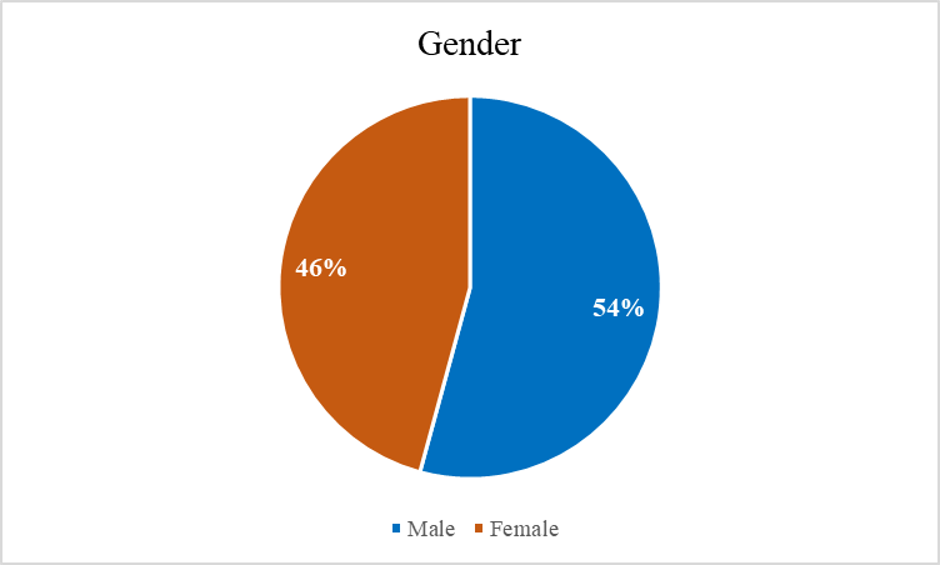
Source: Primary Data, 2024
The survey captured a total of 343 respondents, with a relatively balanced gender distribution. Female participants accounted for 157 respondents (46% of the sample), while male participants numbered 186 (54%). This composition demonstrates near-equal representation, with only a slight skew toward male respondents.
The 8-percentage-point difference suggests that the study achieved a reasonably balanced gender representation, crucial for ensuring that perspectives from both genders are well- represented in the research findings. This distribution allows for meaningful comparisons between male and female responses across various survey questions, enhancing the generalizability of the results to a broader population.
Due to the cultural context and sensitivity of the study population, no other gender identities were included in the research demographics.
Gender Distribution
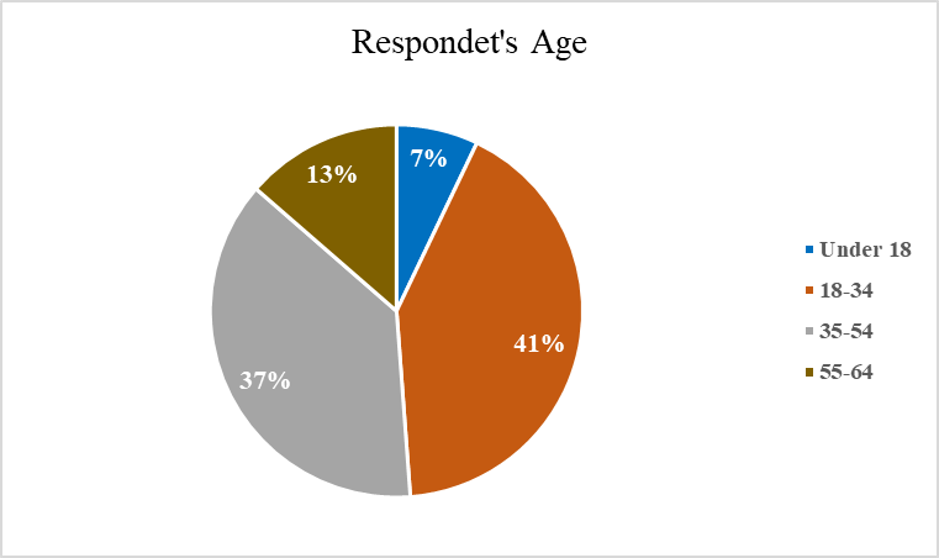
Source: Primary Data, 2024
Age Group 18-34
This group represents the largest portion of the survey respondents, with 150 individuals making up 44% of the total sample. The strong presence of this age group suggests that the survey topic or distribution method resonated well with younger adults. Their responses may offer valuable insights into emerging trends, tech-savvy perspectives, and the priorities of the younger workforce. Additionally, given that this age group is typically more active and engaged, it is plausible that they allocated time efficiently to participate in the survey and may also prioritize voting activities.
Age Group 35-54
With 135 respondents, accounting for 39% of the sample, this cohort represents the second- largest age category. It likely includes established professionals and individuals in their prime earning years. Their considerable representation ensures that the survey reflects the perspectives of those who often hold leadership roles and possess extensive work and life experience. Responses from this group may provide a balanced blend of innovative thinking and traditional approaches, offering a valuable middle-ground perspective essential for comprehensive analysis and decision-making.
Age Group 55-64
Comprising 53 respondents, or 15% of the sample, this group includes late-career professionals and individuals nearing retirement. While smaller than the younger cohorts, their participation still offers meaningful insights into the experiences of older workers. Their responses may shed light on career longevity, workplace changes over time, and perspectives shaped by extensive professional experience. This group’s input is critical to understanding intergenerational workplace dynamics and addressing the needs of older employees.
Age Group 65+
With only 5 respondents, making up 2% of the sample, this group has the smallest representation. The limited participation from seniors may be due to factors such as retirement, less engagement with the survey medium, or the demographic characteristics of the target population. Although the small sample size necessitates cautious generalization, the insights from this group could still offer unique perspectives shaped by long-term experience and post- retirement reflections.
Education

Source: Primary Data, 2024.
No Formal Education (24 respondents, 7%)
This group represents a small but meaningful portion of the sample. Their inclusion is valuable as it captures perspectives from individuals with life experiences and skills developed outside traditional educational systems. Their responses could offer insights into alternative learning methods, workplace challenges faced by those without formal education, and the effectiveness of on-the-job training. The relatively low percentage suggests that the survey topic or distribution method may have been more accessible or relevant to individuals with some level of formal education.
Graduate Degree (86 respondents, 25%)
Representing a quarter of the sample, this group brings specialized knowledge and advanced academic training to the survey. Their significant presence suggests that the survey topic might be particularly complex or relevant to those with higher education. Their responses could provide insights into high-level professional perspectives, research-oriented approaches, and more analytical viewpoints on the survey subject.
Some College (112 respondents, 33%)
As the largest educational category, this group reflects strong representation from individuals with partial higher education experience. It may include current students, those who paused their education, or individuals who pursued alternative paths after some college experience. Their perspectives offer a unique blend of academic exposure and practical experience, highlighting the value of both formal and informal learning.
Bachelor’s Degree (89 respondents, 26%)
This group, comprising about a quarter of the sample, brings perspectives shaped by completed undergraduate education. Their substantial presence ensures that the views of college-educated professionals are well-represented. Their responses may reflect a balance of theoretical knowledge and practical skills commonly associated with a four-year degree program.
High School (32 respondents, 9%)
The data indicates that 32 individuals in the sample have completed high school, representing 9% of the total population under study. This insight sheds light on the educational distribution within the group, highlighting a specific segment with a high school education level. Understanding this breakdown is crucial for informing targeted interventions, educational policies, and workforce development strategies tailored to individuals with diverse educational backgrounds.
Occupation
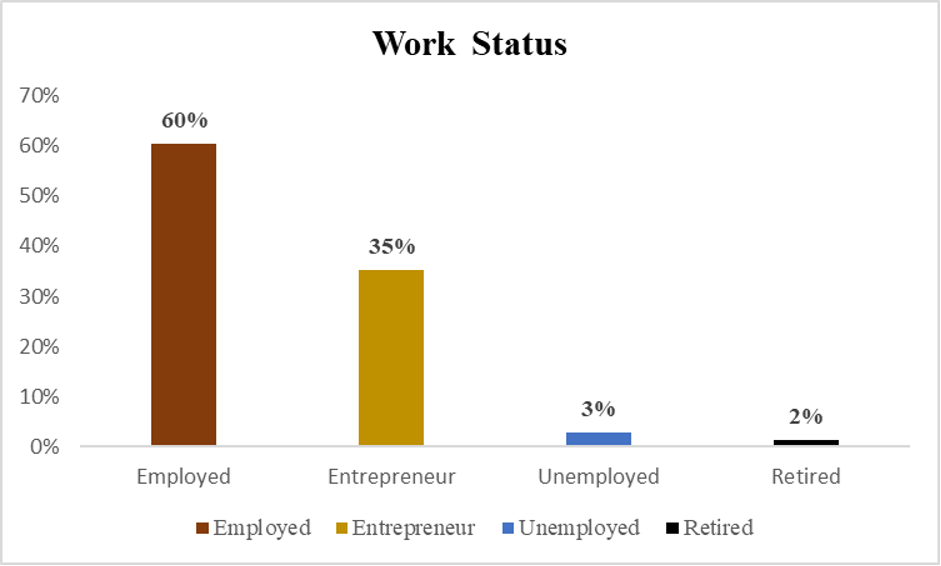
Source: Primary Data, 2024.
Employed (207 respondents, 60%)
This group represents the majority of the survey respondents, accounting for 60% of the sample. The high proportion of employed individuals suggests that the survey captured significant perspectives from the active workforce. This strong representation provides valuable insights into current workplace trends, employee experiences, and professional viewpoints. The responses from this group are likely to reflect contemporary work environments, challenges, and opportunities across various industries and sectors.
Entrepreneurs (121 respondents, 35%)
Representing over a third of the sample, this is a notably large proportion of entrepreneurs. This significant presence suggests that the survey topic or distribution method resonated particularly well with business owners and self-employed individuals. The high percentage of entrepreneurs offers a unique opportunity to gain insights into the perspectives of those who have taken the initiative to start and run their own businesses. Their responses provided valuable information on their perspective of the upcoming election.
Unemployed (10 respondents, 3%)
This small group represents individuals who are currently not employed. While the percentage is relatively low, their inclusion is important to capture a diverse range of employment statuses. The perspectives of unemployed individuals can provide insights into the survey. Including this group to the data collection process as respondents helped to analyse the validity of the data. Moreover, this group showed that they are representable to the state since the unemployment level of the state shaws more similar to our survey unemployment percentage.
Retired (5 respondents, 2%)
This is the smallest group in the sample, representing individuals who have exited the active workforce. Although their representation is limited, their inclusion adds valuable perspectives from those who have completed their professional careers. Their responses added the survey insights regarding all elections they participated and how they see the right candidate should be chosen.
Residences
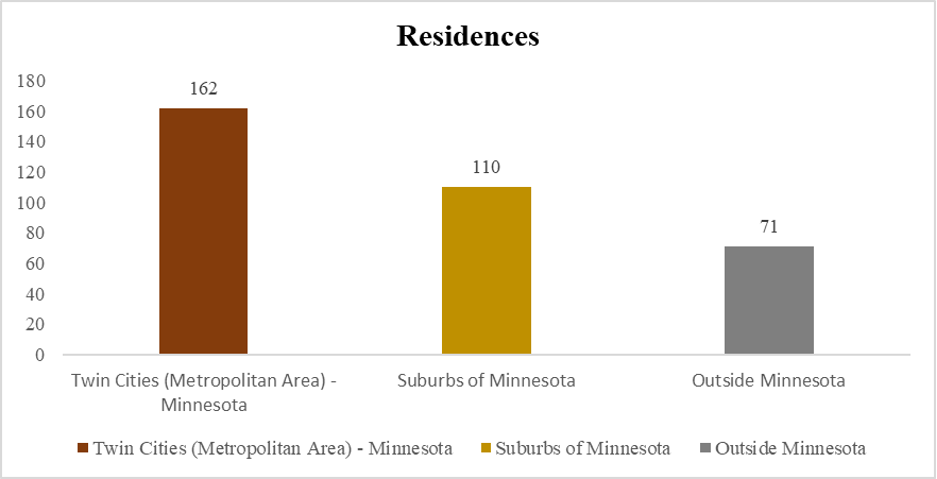
Source: Primary Data, 2024.
Twin Cities (Metropolitan Area) – 162 respondents (47%)
The largest portion of survey respondents comes from the Twin Cities metropolitan area, making up nearly half of the sample. This strong representation suggests that the survey captures a robust urban perspective from Minnesota’s most populous region. The Twin Cities, comprising Minneapolis and St. Paul, are known for their diverse economy, cultural amenities, and concentration of businesses and educational institutions. This high representation provides valuable insights into urban living, work environments, and perspectives shaped by a metropolitan setting. Responses from this group are likely to reflect issues specific to large urban areas, such as public transportation, diversity, and access to various services and opportunities.
Suburbs of Minnesota – 110 respondents (32%)
Representing about a third of the sample, this group offers perspectives from the suburban areas surrounding the Twin Cities. Suburban respondents often include a mix of commuters to urban centers and those working within their communities. Their significant presence provides insights into the experiences of people living in areas that blend urban accessibility with residential environments. Responses from this group may highlight different priorities compared to urban dwellers, such as commuting challenges, work-life balance, and community-oriented perspectives.
Outside Minnesota – 71 respondents (21%):
Although the smallest of the three groups, this category still represents a significant portion of the sample, comprising just over one-fifth of respondents. Including perspectives from outside Minnesota adds an important dimension to the survey, enabling comparisons between Minnesota-based experiences and those from other regions. Responses from this group may provide insights into how Minnesota’s environment, economy, or policies differ from other areas, offering a broader context for interpreting the survey results.
If The Presidential Election Were Held Today, Who Would You Vote for?
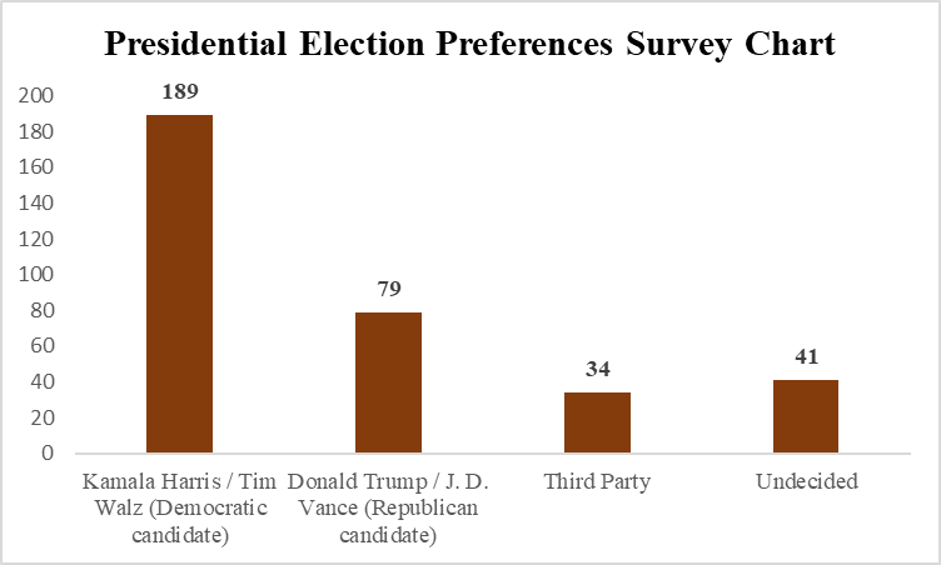
Source: Primary Data, 2024.
- Kamala Harris / Tim Walz (Democratic candidates): They received 189 votes, which accounts for 55% of the total responses. This indicates that they have a significant lead in this poll.
- Donald Trump / J. D. Vance (Republican candidates): They garnered 79 votes, representing 23% of the total. This suggests that they are trailing behind the Democratic candidates by a considerable margin.
- Third Party: This option received 34 votes, making up 10% of the total. This indicates a smaller but notable portion of the electorate is considering alternatives outside the two major parties.
- Undecided: There are 41 voters who are undecided, which constitutes 12% of the total. This group represents potential swing voters who could influence the outcome depending on their eventual choices.
As a Somali American Citizen, Which of the Following Issues Is Most Important to You When Choosing a Candidate?
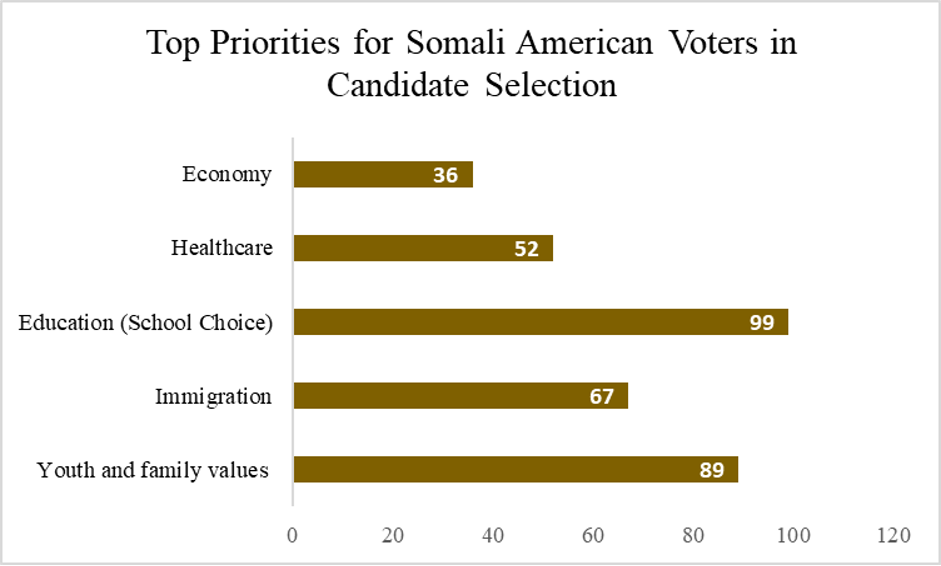
Source: Primary Data, 2024.
Education (School Choice)
This issue received 99 votes, accounting for 29% of the total responses. It is the most prioritized issue among the respondents, indicating a strong interest in educational options and policies related to school choice. This number significantly indicates how important school choice is within the Somali Community.
Youth and Family Values
This category received 89 votes, representing 26% of the total. It is also a significant concern for the respondents, highlighting the importance of family- related issues and values in their priorities.
Immigration
This issue garnered 67 votes, making up 20% of the total. While it is a notable concern, it ranks lower than education and family values in terms of priority among the respondents.
Healthcare
This category received 52 votes, which is 15% of the total. It indicates that healthcare is a relevant issue, but it is less prioritized compared to the top three issues.
Economy
This issue received the least support, with 36 votes, accounting for 10% of the total. This suggests that, while economic concerns are present, they are not as prominent in the minds of the respondents compared to the other issues listed.
What Issues (Criteria) Are Most Important To You In Presidential Candidate?
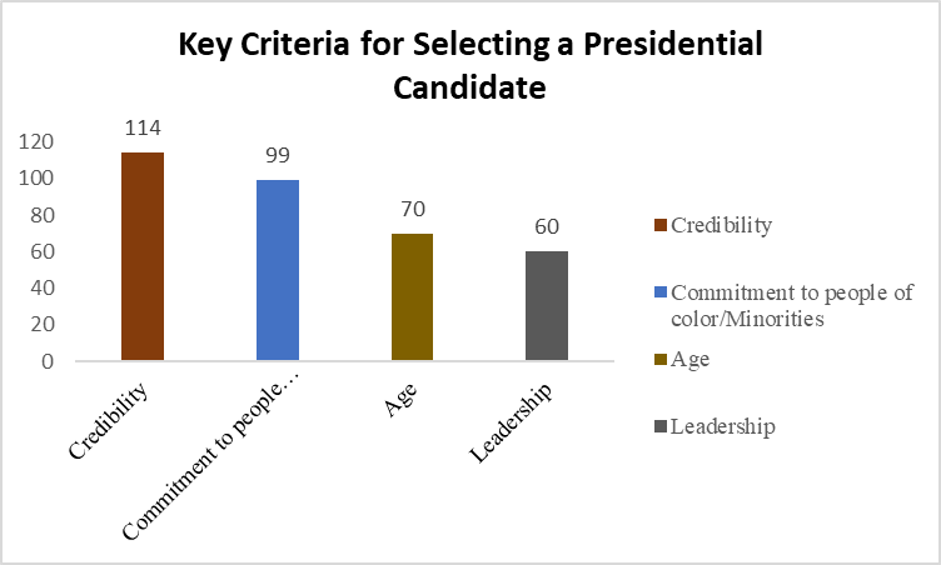
Source: Primary Data, 2024.
Credibility
This attribute received 114 votes, accounting for 33% of the total responses. It is the most valued quality among the respondents, indicating that they place a high importance on the trustworthiness and reliability of candidates.
Commitment to People of Color/Minorities
This quality garnered 99 votes, representing 29% of the total. It is also a significant concern, suggesting that respondents value candidates who demonstrate a strong commitment to diversity and the needs of minority communities.
Age
This attribute received 70 votes, making up 20% of the total. While it is a relevant consideration, it ranks lower than credibility and commitment to minorities, indicating that age is a factor but not as critical as the top two attributes.
Leadership
This quality received the least support, with 60 votes, accounting for 17% of the total. This suggests that while leadership is important, it is viewed as less essential compared to credibility and commitment to people of color/minorities.
Who Did You Vote for in The 2020 Presidential Election?
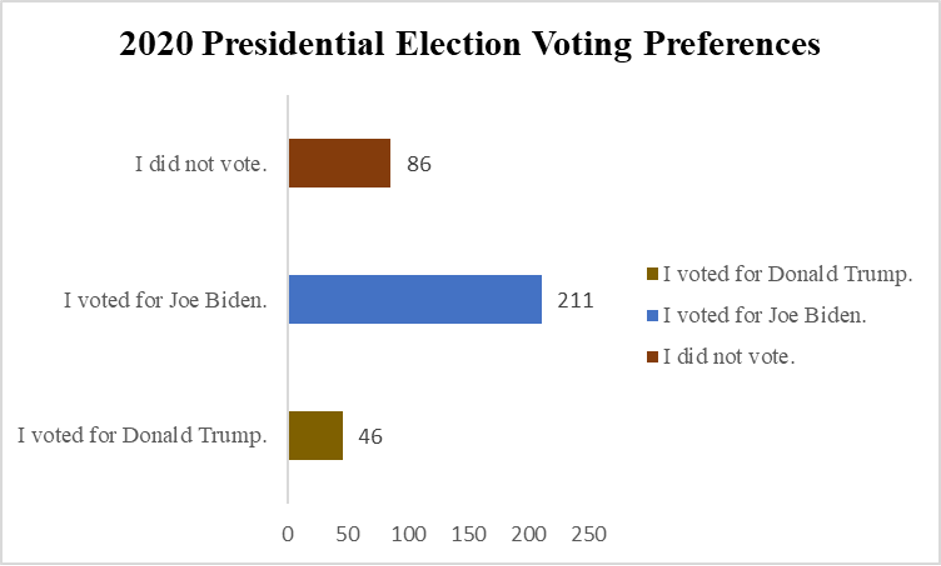
Source: Primary Data, 2024.
I voted for Joe Biden
This option received 211 votes, accounting for 62% of the total responses. This indicates that Joe Biden was the preferred candidate among the majority of respondents, suggesting strong support for him in this context.
I voted for Donald Trump
This option garnered 46 votes, representing 13% of the total. This indicates that Donald Trump received significantly less support compared to Joe Biden, reflecting a minority preference among the respondents.
I did not vote
This category received 86 votes, making up 25% of the total. This suggests that a notable portion of respondents chose not to participate in the election, which could indicate apathy, dissatisfaction with the candidates, or other reasons for abstaining from voting.
As a Somali Community Member, How Important Is It to Vote?
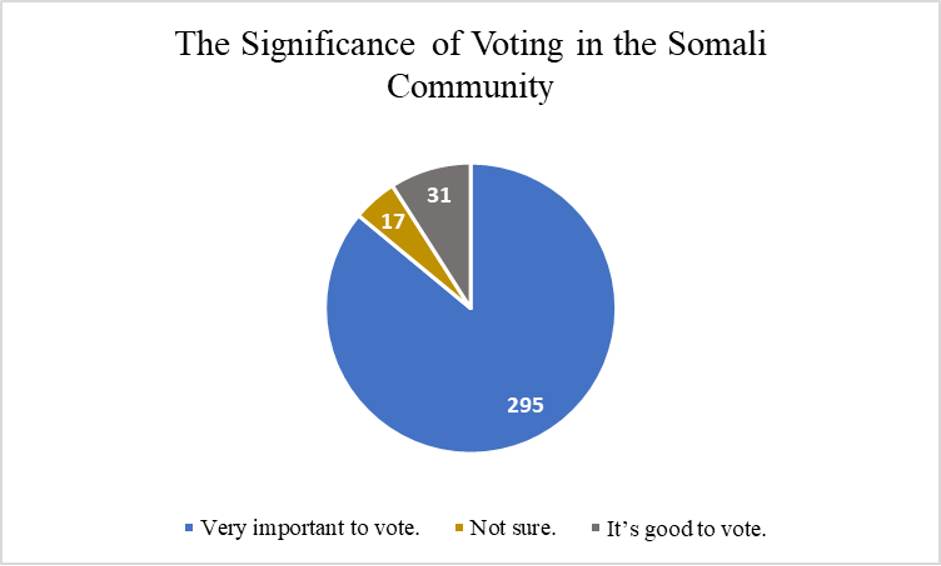
Source: Primary Data, 2024.
Very Important to Vote
This statement received 295 votes, accounting for 86% of the total responses. This indicates a strong consensus among respondents that they believe voting is crucial, suggesting a high level of civic engagement and awareness of the importance of participating in elections.
Not Sure
This option garnered 17 votes, representing 5% of the total. This indicates that a small minority of respondents are uncertain about the importance of voting, which may reflect a lack of information or engagement with the electoral process.
It’s Good to Vote
This statement received 31 votes, making up 9% of the total. While this indicates a positive view of voting, it is less emphatic than the first statement. It suggests that while some respondents recognize the benefits of voting, they may not view it as critically important as those who selected the first option.
How Many Times Have You Voted in Past Presidential Elections?
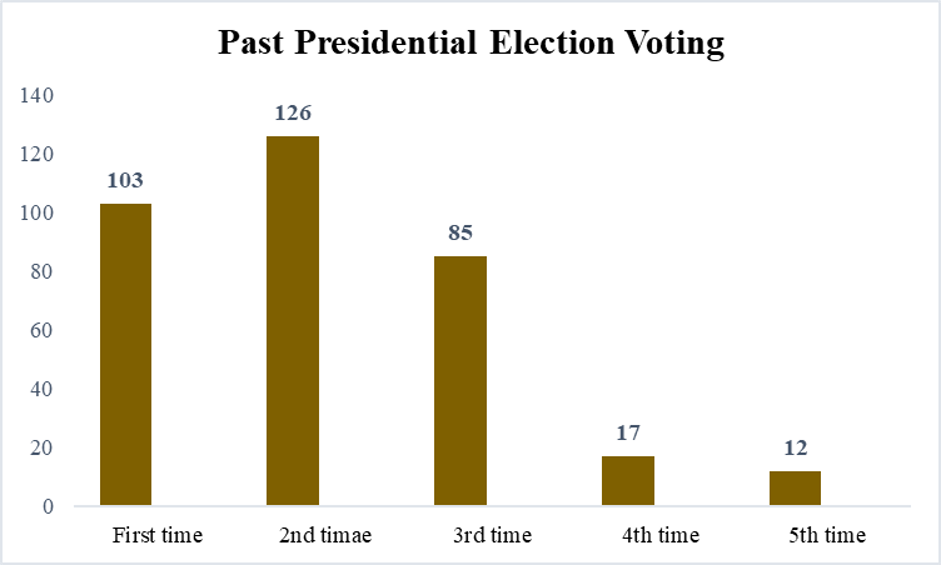
Source: Primary Data, 2024.
2nd Time
This category received 126 votes, accounting for 37% of the total responses. This indicates that the largest group of respondents are voting for the second time, suggesting a significant level of engagement among relatively new voters.
First Time
This option garnered 103 votes, representing 30% of the total. This indicates that a substantial portion of respondents are first-time voters, reflecting a positive trend in civic participation among new voters.
3rd Time
This category received 85 votes, making up 25% of the total. This suggests that a notable number of respondents are voting for the third time, indicating continued engagement in the electoral process.
4th Time
This option received 17 votes, accounting for 5% of the total. This indicates that fewer respondents are voting for the fourth time, suggesting a decline in participation as the number of voting experiences increases.
5th Time or More
This category received the least support, with 12 votes, representing 3% of the total. This suggests that very few respondents have voted five times or more, indicating that long-term voters are a small segment of the overall group.
Party Support Comparison: Democratic Party and Republican Party.
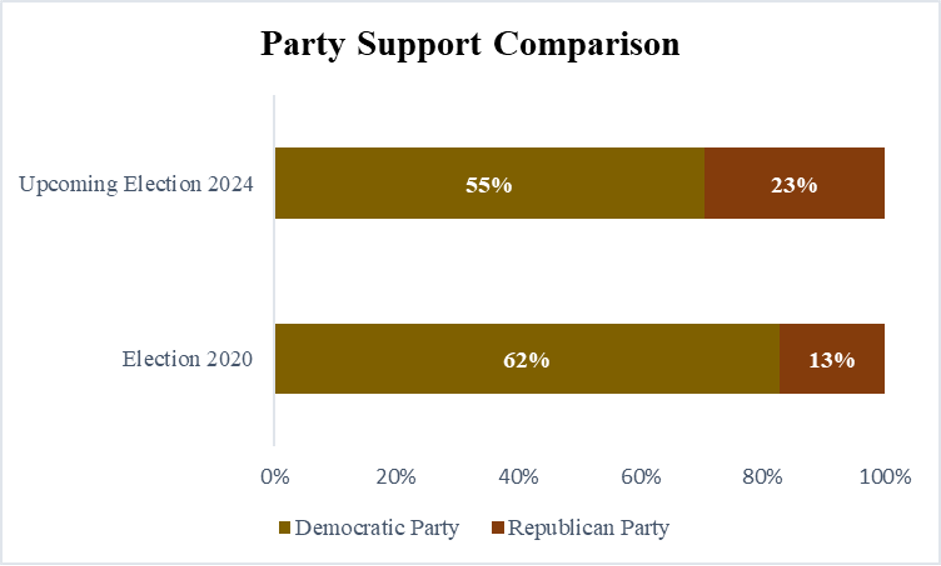
Source: Primary Data, 2024.
The data illustrates a shift in party support from the 2020 election to the upcoming 2024 election. The Democratic Party, which held 62% support in 2020, has experienced a decrease to 55% for the upcoming election. In contrast, the Republican Party has seen an increase in support, rising from 13% in 2020 to 23% for the 2024 election.
Recommendation
1. Importance of Voting and Electoral Participation
The research emphasizes the need for the Somali community in Minnesota to actively participate in voting and electoral processes. Developing awareness about the importance of voting and understanding who to vote for based on programs and interests is crucial. The survey findings highlight the significance of electoral participation in ensuring proper representation and promoting the community’s role in democratic governance.
2. Citizenship Education in Civic Programs
The findings highlight the pressing need for the Somali community to receive citizenship education as part of a broader civic education framework. This would involve the development and implementation of targeted curricula to raise awareness about citizens’ rights and responsibilities and encourage active participation in democratic processes.
3. Community-Based Workshops and Seminars
In addition to formal education, the research recommends organizing community-based workshops and seminars on civic education. These events should be designed to be accessible to adults, particularly those who may not have had the opportunity to pursue formal education.
4. Government and NGO Partnerships
The research suggests forming partnerships between the government and non-governmental organizations (NGOs) to design and implement civic education programs. Such collaborations can pool resources and expertise, ensuring the creation of effective educational initiatives.
5. Multilingual Educational Resources
To account for the linguistic diversity within the Somali community, it is recommended that civic education materials be made available in multiple languages, including Somali, Arabic, and English. This will promote inclusivity and enhance understanding of the content.
6. Focus on Youth Leadership
Given the importance of youth in shaping the community’s future, special attention should be given to youth leadership programs. These programs should aim to empower young people to become active participants in civic life, enhancing their understanding of governance and community service.
7. Expanded Research Scope
The research recommends conducting a broader study to reach a larger number of respondents. This can be achieved through diverse research methods, such as surveys, interviews, focus groups, and ethnographic observation. Combining quantitative and qualitative data collection will provide comprehensive insights and enhance the validity of the findings.
Conclusion
This research highlights the critical need to enhance civic education within the Somali community, emphasizing the importance of understanding citizenship rights and responsibilities to foster active participation in democratic processes. Several recommendations have been proposed to address these needs.
First, the importance of voting and electoral participation: The research highlights the need for active participation by the Somali community in Minnesota in elections and electoral processes. This requires raising awareness about the significance of voting and understanding how to select candidates based on programs that align with the community’s interests. The survey findings indicate that electoral participation is essential for achieving fair representation and ensuring the community’s effective contribution to democratic governance.
Additionally, expanding the scope of research is essential to gather broader insights from a more diverse respondent base through various methodologies, such as surveys and focus groups. Developing targeted citizenship education curricula is also necessary to equip community members with the knowledge required for effective civic engagement.
Organizing community-based workshops and seminars will further facilitate access to education, particularly for adults who may not have had the opportunity to pursue formal education. Partnerships between government entities and non-governmental organizations (NGOs) are also recommended to leverage resources and expertise for creating impactful civic education programs. Furthermore, providing multilingual educational resources will ensure inclusivity and improve understanding among the community’s diverse linguistic groups.
Moreover, a focus on youth leadership initiatives will empower the younger generation to take an active role in civic life, contributing to the community’s development and engagement in the future.
Finally, the research findings highlight several key priorities within the Somali community, such as school choice, family and youth values, and public safety, which align closely with positions typically associated with the Republican Party. However, the community’s ongoing support for the Democratic Party reflects that candidate credibility and trustworthiness are the most valued qualities for them. This indicates that trust and reliability play a decisive role in the community’s voting behavior. Furthermore, it demonstrates that the Democratic Party’s openness and commitment to diversity and inclusion, especially with minorities and people of color, are significant factors in maintaining the Somali American community’s loyalty, despite some alignment with Republican values on certain issues.
Acknowledgments
This report is a collaborative effort that relies on the input and analysis of a group of talented researchers and creative designers. We would like to express our sincere gratitude to the following teams:
Research Team
Internal Ethics Board
Digital Producer, Media and Web Publishing
Communications and Editorial
Bayan Research Center gratefully acknowledges the support of diverse groups, companies, individuals, and endorsements from the community. Your continuous contributions have enabled the success of our Center and have allowed us to offer a wide range of services at both local and global level. Your donations help us advance our Center and facilitate the implementation of highly anticipated programs.
Our annual financial report can be found online. The findings, interpretations, and conclusions in this report are solely those of the author(s) and are not influenced by any donor.
Bayan Research Center
3055 Old Hwy 8 St. Anthony, MN 55418 – USA
612-345-7092
